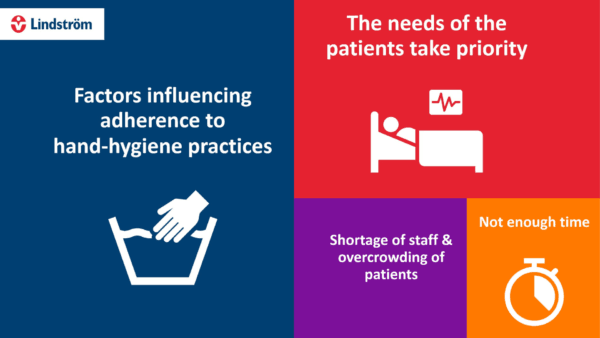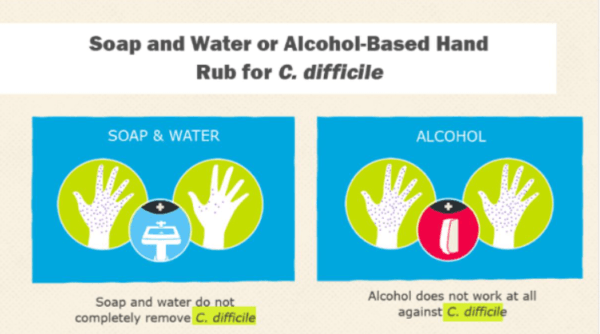Opening up the art of washing hands
Washing hands is usually a quite short procedure that you just do not put any thought into. Lindström’s Aniruddha Banerjee opens up the art of good hand hygiene and explains why it is worth spending a few minutes in, especially when working in healthcare.
Practising good hand hygiene is a simple and effective way to prevent infections. Cleaning your hands can prevent the spread of germs, including those that are resistant to antibiotics and are becoming difficult, if not impossible, to treat. On average, healthcare providers clean their hands less than half of the time they should. About one in 31 hospital patients has at least one healthcare-associated infection on any given day.
In an observational study done at the Geneva University Hospitals by D Pittet, P Mourouga, T V Perneger, it was noted that in 2834 observed opportunities for handwashing, average compliance was 48%
Standard precautions are a set of infection control practices that healthcare personnel use to reduce transmission of microorganisms in healthcare settings. Standard precautions protect both healthcare personnel and patients and include::
- Hand hygiene (handwashing with soap and water or use of an alcohol-based hand sanitizer) before and after patient contact and after contact with the immediate patient care environment.
- Personal protective equipment (PPE) when exposure to blood, body fluids, excretions, secretions, mucous membranes, or non-intact skin is anticipated. PPE includes:
- Gloves – when hand contamination is anticipated.
- Masks and eye protection – when splashes may occur.
- Gowns – when soiling of clothes may occur.
Standard precautions should be used for all patients, all the time, regardless of the patient’s diagnosis..

The basics of good hand hygiene
When should I practise hand hygiene?
- Whenever hands are visibly dirty or contaminated.
- Before:
- having contact with patients
- putting on gloves
- inserting any invasive device
- adjusting an invasive device
- After:
- having contact with a patient’s skin
- having contact with bodily fluids or excretions, non-intact skin, wound dressings, contaminated items
- having contact with inanimate objects near a patient
- removing gloves
But I didn’t touch the patient – Why should I practise hand hygiene? Because bacteria can survive for several days on patient care equipment and other surfaces such as bed rails, IV pumps, and computer keyboards.
Why are alcohol-based hand rubs good?
- Alcohol-based hand rubs kill bacteria in a quicker and more efficient manner than soap and water.
- They are less damaging to the skin than soap and water.
- They require less time than handwashing with soap and water.
- Bottles/dispensers can be placed at the point of care so they are more accessible.
When should I use gloves?
You should use gloves when hands may become contaminated with/by:
- Blood, body fluids, excretions, or secretions
- When touching mucous membranes or non-intact skin
- Contaminated surfaces or objects
Common problems with glove use are failure to:
- Wear gloves when touching open wounds or mucous membranes, such as the mouth and respiratory tract.
- Wear gloves when touching items that are likely to be contaminated, such as urinary catheters and endotracheal tubes.
- Change gloves between patients.
- Remove gloves after patient care.
Don’t forget hand hygiene after removing gloves. Gloves are not a replacement for hand hygiene!
What about hand lotions?
Hand lotions are important to prevent skin dryness and irritation. You should use only hospital-approved hand lotions. Other lotions may:
- make hand hygiene less effective
- cause breakdown of latex gloves
- become contaminated with bacteria if dispensers are refilled
What about my fingernails?
The World Health Organization (WHO) and AORN recommend against healthcare workers wearing fingernail polish or artificial nails, in addition to keeping fingernails short to about ¼ inch prevent the spread of pathogens
Efficacy of promotion and impact of improved hand hygiene
 Evidence shows that improved hand hygiene can reduce health-care–associated infection rates. Failure to perform appropriate hand hygiene is considered the leading cause of health-care–associated infections and spread of multi-resistant organisms and has been recognized as a substantial contributor to outbreaks. Among hospital-based studies of the impact of hand hygiene on the risk of health-care–associated infections, the majority demonstrated a temporal relationship between improved hand-hygiene practices and reduced infection rates.
Evidence shows that improved hand hygiene can reduce health-care–associated infection rates. Failure to perform appropriate hand hygiene is considered the leading cause of health-care–associated infections and spread of multi-resistant organisms and has been recognized as a substantial contributor to outbreaks. Among hospital-based studies of the impact of hand hygiene on the risk of health-care–associated infections, the majority demonstrated a temporal relationship between improved hand-hygiene practices and reduced infection rates.
In one of these studies, endemic MRSA in a neonatal intensive care unit was eliminated 7 months after introduction of a hand antiseptic (1% triclosan); all other infection-control measures remained in place, including the practice of conducting weekly active surveillance by obtaining cultures . Another study reported an MRSA outbreak involving 22 infants in a neonatal unit. Despite intensive efforts, the outbreak could not be controlled until an antiseptic was added (i.e., 0.3% triclosan); all previously used control measures remained in place, including gloves and gowns, cohorting, and obtaining cultures for active surveillance.
Gloves play a key role in managing C. difficile infection
Clostridium difficile (CD) is the most common cause of healthcare associated infectious diarrhea. It is usually a side-effect of taking antibiotics.
C. difficile infection is often acquired as a result of seeking medical care. It is a very common healthcare acquired infection that causes severe and often deadly diarrhoea. It is estimated to be more than 10% of all estimated healthcare acquired infections. C. difficile bacteria forms spores that can be transmitted between patients via the hands of healthcare providers who become transiently contaminated after contact with symptomatic patients or their surrounding environment. These spores are temperature tolerant, can survive in oxygen and last in the healthcare environment. C. difficile spores are not killed by alcohol. Alcohol is commonly used in the laboratory to isolate C. difficile because while it kills other bacteria, it allows C. difficile spore to survive. While alcohol based handrubs are highly effective against nearly all other pathogens in healthcare settings, they have no effectiveness against C. difficile spores.
As a Healthcare worker, what can I do?
Be a role model at your facility.
Colleagues, trainees, and other staff watches what you do:
- Research has shown that the actions of clinicians influence the behaviour of others.
- Show your colleagues that hand hygiene is an important part of quality care.
Your patients watch you too:
- Your actions send a powerful message.
- Show your patients that you are serious about their health.
